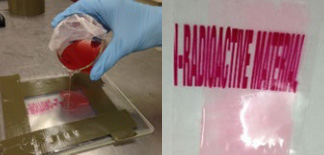Tech Briefs
Savannah River National Laboratory
Alpha/Beta Radiation Shielding Materials
Technology Overview
Savannah River National Laboratory (SRNL) has developed a polymer material effective at shielding and resisting degradation from both chronic low dose and acute high dose alpha and beta radiation. The additive based approach can be applied to any polymer matrix including glovebox gloves, latex gloves, fixtures, tools, instruments, PPE, etc.).

Benefits
- Enhancing alpha/beta shielding from radiation exposure
- Stable non-toxic additives that can be incorporated into cast mold
- Extremely low cost and disposable
Applications
- Degradation resistant glovebox gloves
- Radiation induced degradation resistant containment bags
- Radiation resistant tools
Description
Alpha/beta radiation barrier materials and structures formed to include the barrier materials are described. Barrier materials include a matrix and particulate materials contained in the matrix. The particulates include alpha/beta radiation absorbers. Alpha/beta radiation absorbers of the barrier materials can be molecular, particulates, or defined nanostructures that are capable of absorbing incident alpha/beta particle energies. Matrix materials can include organic or inorganic materials including thermoplastic polymers, thermoset polymers, glasses, ceramics, etc.
As a result, there is a need to provide an improved method of preparing carbon quantum dots. In particular, there is a need to provide a method of preparing carbon quantum dots that allows for the ability to control or tune the properties, such as the photophysical, electronic, and/or quantum confinement properties.
A barrier material can be utilized to form a containment or protection device, with preferred devices generally depending upon the specific nature of the barrier material. For example, a flexible barrier material (e.g., an organic polymeric-based barrier material or a fibrous organic or inorganic based barrier material) can be used in forming containment bags and personal protective equipment (e.g., gloves, face shields, body suits, etc.). Additionally, a non-flexible barrier material, e.g., a ceramic or glass panel, and or an organic thermoset polymer-based structure, can be utilized to form a non-flexible containment structure or shielding structure.
Intellectual Property
The technology has been granted U,S, Patent No. 10,340,049 (July 2, 2019), “Alpha/Beta Radiation Shielding Materials.”
Partnering Opportunities
SRNL invites interested companies with proven capabilities in this area of expertise to develop commercial applications for this process under a cooperative research and development agreement (CRADA) or licensing agreement. Interested companies will be requested to submit a business plan setting forth company qualifications, strategies, activities, and milestones for commercializing this invention. Qualifications should include past experience at bringing similar products to market, reasonable schedule for product launch, sufficient manufacturing capacity, established distribution networks, and evidence of sufficient financial resources for product development and launch.
Download Tech Brief
Contact Information
Savannah River National Laboratory
E-mail: partnerships@srnl.doe.gov